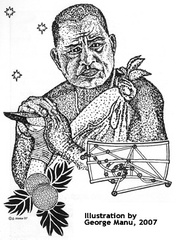Ku Holo Mau**Sail On, Sail Always, Sail Forever

The canoe, Maisu is the latest effort in an odyssey to reestablish traditional ocean voyaging using the art and science of wayfinding practiced by the ancient Polynesians. The inception of the Polynesian Voyaging Society in 1973, began the process of reconnecting with the lost art of wayfinding practiced more than 800 years ago by Polynesian voyagers. Hokule’a’s first voyage in 1976, navigated by master navigator Mau Piailug, provided the inspiration for the building of canoes throughout Polynesia, the training of successive generations of navigators and many historic voyages. But none of this would have been possible without Mau’s generous gift of the knowledge of traditional navigation. The ocean voyagers of Hawaii wanted to give something back to Mau and to the younger generations in Micronesia; Maisu was the result.
Planning for Maisu began in 2001 when Mau met with several members of the Hawaii Voyaging community. Maisu, a Big Island grassroots effort, coordinated by Na Kalai Wa’a Moku O Hawaii (The Canoe Builders of the District of Hawaii) began its life on Oahu, where the friends of Hokule’a and Hawai’iloa constructed the twin hulls. Young Brothers then shipped the hulls without charge, from O’ahu to Kawaihae, in September 2003, where the majority of the work to build the canoe began. This involved a core group of people headed by the late master navigator, Clay and his brother Shorty, as well as Steve Garrett (master boat builder) and scores of volunteers who gave what they could. “Clay’s daughter Pomai Bertelmann of Nā Kalai Wa’a Moku O Hawai’i pointed out ‘we had people from New Zealand, Argentina, South Africa, Japan, Hawai’i, California, we had people from all over the world working on this canoe. We couldn’t have asked for more.’” (Malama Hawaii News)
Rather than being constructed from blueprints, the design evolved based on the purpose and available materials. Weaving all the factors together, Maisu evolved in what seemed to be a dialogue between the spirit of the canoe and her builders.
First they looked at Makali’i to evaluate what worked about the design and what didn’t work. “We also had to look at the waters where Mau lives. The traditional Micronesian canoe has a much sharper hull because they need to sail more to the windward. But Hawaiian sailing canoes have much more rounded hulls because there is much more of a lee drift.” (Paishon) This means there is a drift to the west, which in Hokule’a’s case would have caused the canoe to miss Tahiti, a few degrees longitude east of Hawaii. However, because Mau’s plan is to teach as many people as he can while his health permits, he requested a large Hawaiian voyaging canoe to accommodate larger groups.
The mast and the sails, however, needed to work for the wind conditions it would encounter in the various Micronesian island groups. “Normal windspeed in Micronesia is 5-10 knots, which means they need to use very large sails and need taller masts to support them.” (Paishon) Recent sea trials in much windier Hawaiian waters have sent Maisu flying, proving the effectiveness of the rigging.
The electrical system also had to be designed to work in Micronesian waters. This was designed and installed by Robert Harbison, who was at the recent launching of Maisu. Pointing out a sealed metal rectangular box about 1’x3’x2’, securely attached to the deck, he explained that it contained the electrical system that will be used to charge and power any onboard electronics such as radios. A self-contained modular system perfect for the Micronesian islands, as it can be shipped back to Hawaii for repairs or replacement parts.
Maisu is comprised of two 57 foot hulls, the top sections of which are painted yellow and the bottom sections black. Launched on Dec. 16th at Kawaihae Harbor, captained by Shorty Bertelmann, Maisu will soon begin her maiden voyage. The first leg of the voyage, crewed by five Micronesians and one Maori and seven Hawaiians, will take Maisu to Majuro in the Marshal Islands, where there will be a crew rotation. From there Maisu sails to Ponape and Truk, in the Truk Islands, continuing to exchange crew members along the way. The final destination in the Carolines includes stops on Pulap, Satawal (Mau’s home island), Woleai, Ulithi and Yap.
Mau returned to Satawal last June, but is in regular contact with Chadd. Although, due to failing health, Mau has limited time to carry out his mission, “… every navigator has a backup plan.” His son, Sesario, has decided to carry on Mau’s work and Mau also feels secure in the knowledge that, “…he has planted the seed in Hawaii.” The voyage has come full circle. The breadfruit that came to Hawaii and fed the travelers who found their way through the mysterious ocean forces will, through Mau’s gift of wayfinding, return to the source.
The crew still needs tickets for their return flights from Micronesia. Donations can be made to: Attention Maisu Crew Airfares / Kalai Wa’a Moku O Hawaii/
**Name given by Pua Kanaka’ole
 RSS Feed
RSS Feed
